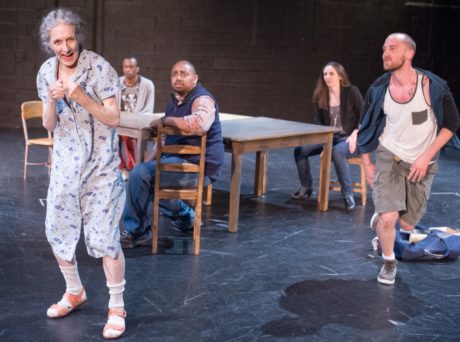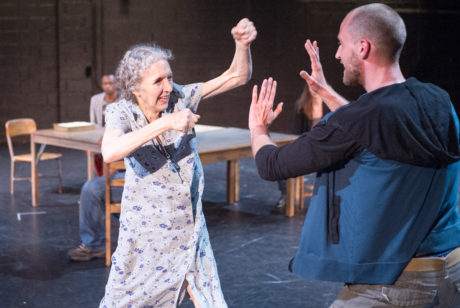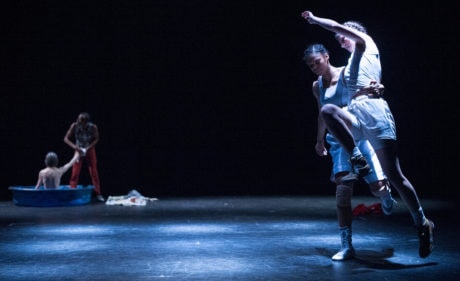Still Life With Rocket is greater than the sum of its arts. The diverse forms of installation, choreography, and character-driven drama come together in this collaboratively devised experience in what seems a wholly new way. It happens on the entire first floor of the Anacostia Playhouse, including hallways, dressing rooms, and a mobile-home structure on the loading dock. Audiences enter at intervals in small groups, slowly pass through installations of interiors created in realistic detail, and then take a seat in the vast black box where a kinetic performance is in progress. Discovering the originality and emotional energy in this not-easy-to-describe theater experience can make one feel like a voyager into the not-yet-known.
The word rocket in the title refers partly to Voyager, the spacecraft launched in 1977. Seventeen-year-old Nathan (Justin Weaks) identifies with that rocket. He makes school projects about it, pens poems about it, imagines its trajectory into the far beyond. Nathan is sole caretaker to eighty-something Etta (Annie Houston), the woman who raised him like a son. Now she is frail, her memory failing, her former life as an amateur boxer long gone. Rocket was also the nickname of a daughter whom Etta lost and occasionally remembers in mourning.

Still Life with Rocket was conceived and directed by Mollye Maxner, the visionary prime mover behind the powerful and heartrending Occupied Territories at Theater Alliance two years ago. Still Life with Rocket, which has been in development since, represents a singularly original advance in Maxner’s body of work and a significant innovation in theater practice. I was grateful that she agreed to this in-depth interview about it.
John: What multimedia theater artists have inspired you?
Mollye: I’ve been watching everything from Wooster Group to William Forsythe to Robert Wilson to Robert Lepage to Big Dance Theater. Pina Bausch has been a big influence. Complicite. DV8. Those companies have been inspiring to me ever since I was 12. The theater that I most love is theater that is kinetic in some way and that uses whichever mediums are required to tell that particular story.
What did you want to do that was different?
When I had the idea for Occupied Territories—which actually started as an idea for an all-male Trojan Women—it came from two impulses. One was about content: looking at the role of the soldier from a complex point of view. My dad was a soldier, and I wanted to look at the relationship between humanness and atrocity.
There was also a formal impulse: how do you put really complicated and sophisticated kinetic language—Dance with a capital D—together with very realistic, character-driven, relationship-driven themes? Occupied Territories ended up taking a different formal path and thus didn’t get to ask that question. But I left Occupied Territories still wanting to investigate the relationship between kinetics and reality-based scene work—what we picture when we think of Arthur Miller or Sam Shepard, for instance.
I wanted to put kinetics and scene work together. Other directors and choreographers are investigating similar questions, but I have not seen it before in this particular iteration. And I wanted to see what happens when you put the two forms together without making one form move toward the other. Does that make sense?
Absolutely. And it will surely make sense to people after they’ve seen Still Life with Rocket. I’ve never seen the two forms merged like this either. The movement was always integrated into another dimension of storytelling. There just wasn’t any dance for dance’s sake in it.
Right.
Occupied Territories had an autobiographical element to it—your father served in Vietnam. Does Still Life with Rocket?
The content is personal, but the story is not autobiographical. This was a dive into the imagination as opposed to my personal history.
What were the beginning impulses in terms of content that led you to create Still Life with Rocket?
The very bottom, the bedrock of it, has to do with the relationship between tenderness and aggression. How is aggression sometimes incredibly useful, when is it not useful, and when is aggression tender and intimate—just how do those two things interplay?
I went to a talk by Stephen Jenkinson, a Canadian who has a school called the Orphan Wisdom School. He dedicates his life to talking about dying. And that was very moving and intriguing to me, because I was there thinking, I really have no idea what he’s talking about. So dying made its way in, aging and dying. And as I was thinking about aggression and what I was most afraid of—in terms of that relationship to a kinetic experience—it was boxing. And so we brought together boxing and aging.
We started from four content threads, actually—boxing, aging, interracial adoption, and the spacecraft Voyager—all within this question of kinetics.
The Voyager has been there from the beginning. And the reason the Voyager has been so intriguing to me is the fact that in our desire to catalog humanity for another species to see, we purposely left out poverty, disease, nudity, war, art. There’s a lot of things that for different, and very considered, reasons they left out. The fact of those omissions was a really deep river underneath this piece. What are the things that we don’t like to look at, inside of just a regular human family? And what happens when we come together and those things bump up against each other?
The dying, the adoption, and the boxing content has a clear of-course-ness to it. The Voyager has a huge metaphorical embrace of the piece.
When we began to workshop the piece two years ago, we had a completely different story. The story changed many times, but the four threads remained. The Voyager content thread came and went many times. I hoped it would find its way into the final piece (even as the makers we don’t have total control over these things!). The story that formed its way into Still Life with Rocket did not arrive until January. We are thankful that the Voyager was a part of that.

Who is “we”?
It changed. The design team was always on board [Scenic Designer Andrew Cohen, Costume Designer Kelsey Hunt, Lighting Designer William K. D’Eugenio, Projections and Multimedia Designer Kelly Colburn, Sound Designer and Composer Matthew M. Nielson, Properties Designer and Set Dressing Patti Kalil], but they were not necessarily in the workshops at the beginning.
The team of actors shifted a lot. Teresa [Spencer], Justin [Weaks], and Annie [Houston] were there from the beginning. There were a few others, and as they left for other projects, the piece kept changing, because I was committed to building the piece for and with the people we had. So as new people came in, the piece shifted.
And this was all under the auspices of Theater Alliance’s commission?
Yes.
I just think it’s amazing that that theater company took on this much innovation and this much content and this much importance.
Oh my gosh. I’m in awe of Colin [Hovde, producing artistic director].
But it also strikes me as a high-water mark in terms of commissioning work in the DC theater landscape, because it catalyzed creation of a new theatrical form.
Usually working on a new play, you write and you have a reading and then you write and you have another reading, and then you write and you might have a staged reading—it’s this long process with a lot of writing work beforehand, and until it’s really ready you don’t do a production. The risk Colin took on this project was to basically start the writing six weeks before the show opened—on the model of working as a choreographer, where you have six weeks to build a movement piece and then there’s opening at the end. This pushed us to find form—physical, kinetic form—at the same time as we were finding story, character, and language.
At first one is aware of the show’s component parts, its different arts—the installation, the movement, the narrative storytelling and characters, the scene work. But as one takes the show in, it comes together like a seamless whole. At the end you can’t parse it apart; it’s all of an extraordinary emotional piece. I walked out not having a sense of where the dance began and ended and where the scene work began and ended.
I’m so glad, because that’s what we were going for—to be able to have each intact but to have the way that they’re relating and what they’re doing to the experience of the viewer, the audience, be integrated.

I’d like to go back to those components and take them apart and talk about them. You know the way on a DVD extra the director is talking over the movie—?
Exactly. I want to do that. I want to be like on an earpiece: “Look at this. Turn right. Be sure you catch this.” Because there are so many things that people will not catch. Like, one of the moments I love—that maybe 2 percent of the audience will see—is a little plaque in the house tucked into one of the windows, and it says, “If it’s hungry, feed it. If you drop something, pick it up. If you—“
I read it. I read the whole thing.
And the very last one is “If it cries, love it,” but it’s crossed out in black to say “If it cries, punch it.” That is a massive key into this family. I’m glad you saw it.
Let’s talk about the room installations, since that’s what people experience first. How did that all come to be?
That idea came very early, from a formal idea. When Colin asked for a new work, I said I wanted to do something that uses the theater in a different way. I want the audience’s relationship to detail and scale to be part of the experience. That’s really hard in the theater, because you only get one distance, so scale is pretty uniform. So I said I’d love to have installation be part of this, so that we’re engaging the relationship to scale, distance, and proximity in a different way than we did with Occupied.
When you as an audience member walk through that experience of close-up visual detail, then when you walk into an empty theater space where the rest of the piece takes place, something happens that I can’t explain. It does something to the way one is seeing. If you just walked directly into the empty space, it would be different. I don’t know the science behind it, but I feel like it does something. That was one of the experiments.
Well, I can report that it did do something. I walked in not knowing what I was walking into. I didn’t know where I was or why I was there. I sensed I was in rooms that were lived in, by the people I saw there like living statues. But I didn’t know who they were. I didn’t know they were connected in any way. I couldn’t remember all the details, there were so many. But I lingered enough to have a sense memory of being in someone’s room.
Right.
And then there were moments in the storytelling, in the scene work, when something got said and it triggered a memory of something I saw in a room I was in. I didn’t know this was what you meant to happen; it just happened. It filled in the story. It amplified layers of the storytelling as I was watching it in the big black box.
Right.
Practically speaking, was all that installation an amazing set dresser at work? Or was that collaborative as well?
Yes. Andrew Cohen did the set design. And then a company called Bella Faccia built the mobile home that we put into the loading dock. And then Andrew, myself, and Patti Kalil did all the detailing of it. For instance, where are the pizza boxes? Do the cups go here or there? What do these signs say? And then my husband [Kelly Maxner] and I did all of the murals. So it was a mixture.
Interesting, because it feels like it was all done by the same artistic hand.
That’s so great, because I’ve never been part of something more collaborative. It feels like it’s all of a piece, and yet so many people were engaged in making it.
Were the actors participants in the creation of the installation environments that we first find their characters in?
Yes and no. For instance, Teresa didn’t know what she would be looking at when she was sitting and she said: I think it should be my file from being a foster child. So we made that happen. Same thing with Jared: Can I be looking at pictures of Nathan when he was little?
The play is the story of the Fisk family. There’s the matriarch, Etta [Annie Houston], and the four children she has adopted or birthed or taken in [Nathan (Justin Weaks), Tracy (Teresa Spencer), Cyrus (Jared Shamberger), and Caleb (Ben Gunderson)]. As we find out their relationships to Etta and to one another, each of their stories comes as an emotional revelation. How did you know going in who the characters were in this family?
It emerged out of the casting. I knew I wanted to work with Ben. He and I have known each other for a long time but have never worked together on a project like this. Same thing with Justin; I’d seen his work and was excited about working with him. And then Teresa joined in the workshops and was inspiring with her bravery. Annie I’ve known for a long time and was really excited to work with her. And I met Jared on the first day of rehearsal. So the characters really came out of who they are and what they brought to the piece, and the risks they were interested in and willing to take.
When we went into the rehearsal process I knew that there would be an installation. Well, we knew the mobile home, and we knew we wanted the installation to take the audience on a journey that would affect their experience of the piece in the theater space, but we didn’t know what the rest of the installation would be. We knew specific threads of story, but much of it was unknown. I did, however, know that there would be the scene of Nathan washing Etta.
Which was the moment the play caught me emotionally. Up until that point I was kind of lost. I think it’s ok to say to people: You might feel lost.
Yup. For a bit you might. And that’s ok.

I didn’t know what was going on or why. And then I saw Nathan tenderly bathing Etta, who is sitting naked in a kiddie pool, and it was so real and so beautiful my heart stopped. That was the emotional entry point for everything that came after.
Yeah, for me too. And that was the emotional entry point for working on the piece—that image of looking at an aging body, and a child washing his mother. I knew the image would have very little language. Then working backwards, I knew that the moment before it had to be, in terms of phrasing and tempo, something really big, loud, kinetic.
Ah, and therefore the boxing [performed by Devinne Cook and Kate McFalls].
And therefore the boxing: what we needed the moment before that silent scene with Nathan and Etta. But then as we built the boxing material we made discoveries (there are actually many resonances laced within the boxing movement). For instance one discovery we made: seeing Etta halfway through the boxing—seeing the young Etta dancer and the aging Etta at the same time and starting to see the power of a young woman against the frailty of her older self—
We see they have the same tattoo on their calf. And there’s an emotional moment of recognition: this is the same woman young and old. The human connectivity in the play is so rich and has such a rich history, it’s breathtaking. How did all those layers come into being in workshop without a script to start with?
Ben was a very significant collaborator with me starting in this past year in terms of building the structure of the piece. We had an outline that he and I worked on together and Colin had influence in as well. It was terrifying to go in with no script. But it felt important.
In the DVD-extra mode again, can you give me a couple highlights of narrative or dramaturgical discoveries that happened during that devising process and became part of the piece?
This is really hard to answer, because as soon as something changes, I forget that it was any other way. The reality is that every day felt like a surprise. It was an acute experience of sensing the piece amid the web of complex ideas, and seeking through that thick web a clear and relatively simple form to emerge. Like looking again and again through the fog and teasing out form, more and more and more.
It was a process filled with “waste.” We did hours and hours and hours of improvisation. We had potent ideas that we had to keep cutting away, letting them go even though we loved them, because they didn’t serve the story. We were building clear threads with the intentions that the threads would resonate with each other and that the resonance would have the capacity to be greater than the pieces themselves.
For instance, how does the kinetic vocabulary of the dancers in the installation create imagery that impacts the experience of the story? How do tiny actions of hitting and throwing and crashing and sliding connect with the interiors of the characters? What happens in the space between—between the installation and the story? between the movement and the scenes? between the characters and the space?
How are we willing to participate in the quest rather than just passively observe it? How do we trust our own capacities to see and put together? How do we trust the experience that is nonverbal?
We cut so much material. The night before opening, we had an entirely different ending. The day before that we cut six pages from the scene of the children in the ring (leading up to and including the Truth or Dare scene). In a way the first four weeks we were gathering the materials, and then the last two weeks was taking knives to it and paring away.

I want to move to the dance and the movement. A lot of the piece is really big kinetic gestures. There’s intimate scene work, but the throwing of the boxing gloves against the wall, the table-and-chair dance confrontation, the running around the perimeter of the theater while they’re taking off their clothes—what’s amazing is how integrated into the storytelling those big gestures are. The objects seem to locate the dance in the story, so every kinetic gesture has a character objective or a character reality. That amazing scene of turbulent furniture swirling is entirely character-driven.
One of the things we were looking at, particularly in that section, was how can we move from the realistic to the psychological? When is it necessary, when is it useful? And how can we slip from one to the other most effectively?
That brings me again to collaboration, Still Life is the height of my collaborative experience. Everything that exists in this piece has happened in the space between all of us, rather than solely directed by me and everything having to sort of fit into my vision. Formally I’ve held the thread of the vision from the beginning and all the way through. That was my role in this endeavor—to hold the line, the vision, and guide us as best I could. But in terms of content and how it unfolds, that has been driven as well by the performers, by the designers, by our dramaturg [Bob Bartlett], by the co-choreographer [Kelly Maxner]. And it was driven by all the questions, proposals (and refusals!) we all raised every day. And I think right now about Matt Nielson with his sound design. Music is a huge part of the experience of the piece. So for instance in that table section, the intersection between the movement, the content, and the music is where that experience is located. If you take any one of those things away, the experience would be vastly different.
I love work where kinetic expression brings us to places that are not language-based thinking. It brings us to something physical and visceral and emotional, and it has layers of meaning so that people have different ways of seeing it. That means it lets people in. It engages their seeing and reading the story from their own points of view.
That was what struck me during and after the show. It enlisted me in piecing the story together. The play made me a part of the storytelling, because I pulled into what I was watching the memories I got from the installation.
With Still Life with Rocket, details we saw and remember from the installation figure into our understanding of details in the drama before us. We are getting to know a family, family member by family member. And in addition everybody is bringing their own family stories to it. Anyone who has ever had a family member whose memory is in decline or who is frail and in failing health will bring that to it. All the other stories that are told—the drug backstory about Caleb, the parental story about Nathan, the foster story about Teresa—connect to our own lives in different ways, and everybody’s is different. And you have added to it an environmental backstory for the piece that is unlike anything I’ve ever seen.
I was trying to think, Is there a theatrical term of art for this kind of audience participation in storytelling? And I don’t think there is yet.
It’s not immersive theater, which is a big thing right now, but it’s not really that. You get to go through a world, but you don’t really get to touch anything or change it.
And nobody comes up to you and touches you. Nobody tells you, Come dance with me.
There are many parts of it that are different each night. There are pockets of improvisation that the actors are doing. It is certainly a kind of visual and physical theater. But the exciting thing is that I feel that I’m at the beginning of a new quest in relationship to process and to form. Because I don’t really know what this is. I don’t know what it’s called. Maybe the clearest “name” would be to call it a fugue.
Appropriately enough one of the big metaphors in Still Life with Rocket is the spacecraft Voyager, and you really have gone on a new voyage. If I were groping for the theatrical term of art for this form, it would have to go by your name, at least for now. You know, like Brechtian, Grotowskian. Your name is going to have to become an adjective.
Still Life with Rocket is a new kind of ride for me. It’s really just wild to do this work and then have it meet the world.
Running Time: Up to two hours without intermission, depending on time of entry. Audience members are admitted in small groups beginning 40 minutes before listed performance times.
(Additionally, I recommend that people who see Still Life with Rocket take time after the performance to go back to the installations. I found it eye-opening to revisit those environments and to re-see them with what I now knew about the characters whose rooms these were.)
Still Life with Rocket plays through July 2, 2017, at Theater Alliance performing at the Anacostia Playhouse – 2020 Shannon Place, SE in Washington DC. For tickets, purchase them online.
VIDEO:
MUSIC:
“Off the Ground” from Still Life with Rocket at Theater Alliance. Music by Matthew M. Nielson, lyrics and vocals by Justin Weaks.
LINKS:
‘Occupied Territories’ at Theater Alliance by John Stoltenberg
Review: ‘Still Life with Rocket’ at Theater Alliance by Jane Franklin





